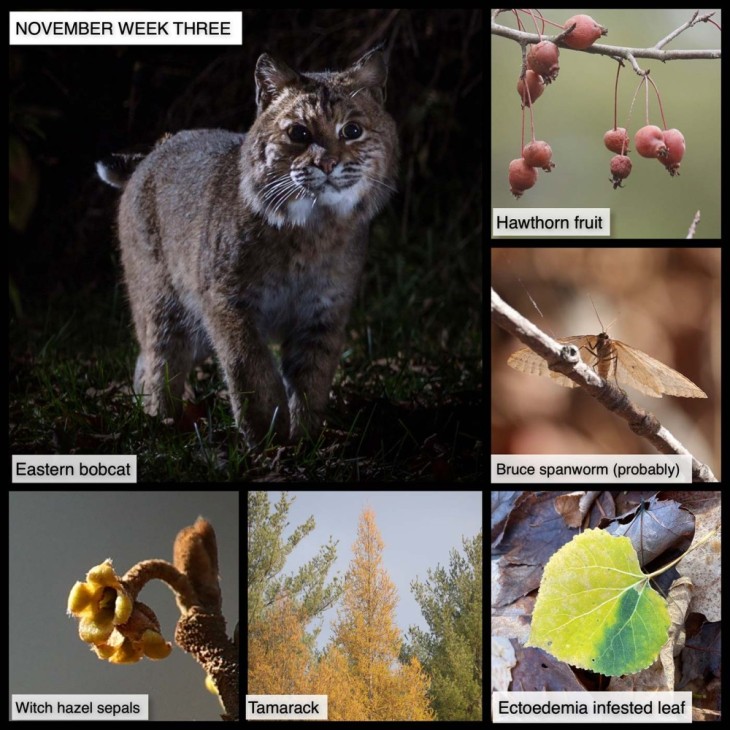This Week in the Woods, our apple orchard photography project continues to yield fun results. In last week’s post, we shared an image of a gray fox. This week, it’s an eastern bobcat’s turn. These elusive wildcats are highly adaptable, and as Jon Litvaitis notes in this article from Northern Woodlands’ Spring 2017 magazine, they’ve made a population comeback in recent decades, despite the aging of so much of the region’s forestland from early succession habitat that promotes favored prey populations (such as rodent and ruffed grouse). Last winter, we found multiple sites where bobcats had caught wild turkeys, and we also discovered several cached deer carcasses. Here’s a profile from the Vermont Fish & Wildlife Department, which explains that one of the reasons people rarely see bobcats is that they’re crepuscular – i.e, most active at dawn and dusk.
Here are some other nature sights (clockwise):
We found a hawthorn tree next to a wetland, decked with fruit. There are 50 plus species of the trees in the Northeast, including naturalized non-native species, and discerning among them is tricky. However, as a general rule, having hawthorns around is great for wildlife. According to Susan Morse, in this article from Northern Woodlands’ Autumn 2014 issue, hawthorn fruit is a star attraction in the fall soft mast buffet. She notes, “I have seen sign of black bears, porcupines, and raccoons feeding within a hawthorn’s thorny fortress, and I have no doubt that fishers, gray foxes, and opossums partake, as well. Numerous species of birds enjoy these marvelous little fruits.” Here's another fun fact about the trees: their widely spaced spines likely evolved to ward off now-extinct megafauna such as ground sloths and mastodons.
If you’ve been out on a woods trail recently, especially if you’ve been passing through hardwood stands, you’ve probably noticed the fluttering of dull white moths rising up and then falling back again into the leaves. What you’re seeing are probably male Bruce spanworm moths. As noted in this Outside Story essay by Bryan Pfeiffer, Bruce spanworms, also called hunter’s moths, have a few anatomical features that help them stay active in the November woods. They have more muscles and low “wing-loading,” allowing them to get more lift and use less energy to fly. The insects also conserve energy by divvying up responsibilities. Females are wingless and devote themselves to egg production. As Pfeiffer notes, “While the males flutter and flex their muscles, the females, full of eggs, simply sit around, usually on a tree trunk.” Note: invasive winter moths are also flying now. Here’s a profile about this look-alike species from Mass Audubon.
Speaking of Bryan Pfeiffer, and moths, check out his University of Vermont blog on “aspen zombie leaves” and then look at the “zombie leaf” specimen in our post, courtesy of Meghan McCarthy McPhaul. As Pfeiffer explains, when you find an aspen leaf still bearing a splash of green, what you may be seeing is the work of an Ectoedemia moth larva. These tiny insects secrete a substance that “keeps part of a leaf alive so that [the larva] can keep eating.”
Tamaracks, our oddball deciduous conifers, have transitioned to bright yellow. They have a number of tricks for getting by in meager soil, combining deciduous and conifer coping strategies. Here’s an Outside Story essay explaining these trees’ energy- and nutrient-conserving strategies, which help them to grow all the way up to the edge of the Canadian tundra. For example, they’re able to recycle a high proportion of nitrogen from their needles before these are shed.
Finally, this is the time of year when we typically make a trip to a local witch hazel shrub, to check out its “second bloom.” These lily-like sepals, hard to the touch, are built to withstand cold weather and will keep their yellow color into winter. Here’s an article about witch hazel, including photos of their flowers and fruit capsules, by Janet Pesaturo.
Our thanks to The Bailey Charitable Foundation and the Frank and Brinna Sands Foundation for helping to support this series.
In this difficult period, many of us find joy in observing local nature. This series, launched in April 2020, shares nature photographs taken in the past seven days, or in the same week in 2020, most within 15 miles of the Northern Woodlands office in Lyme, New Hampshire. We hope you enjoy using this grid as a prompt for your own explorations.
What are you seeing in the woods this week? Share your images with us on Facebook, or submit a special photo for possible inclusion in our monthly online Reader Photo Gallery.


